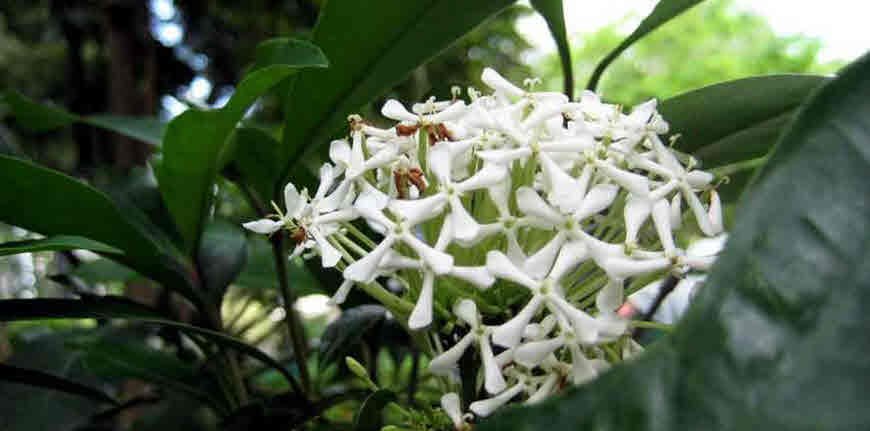Ixora pavetta (Syn Ixora Parviflora Vahl), is a small flowering tree found in gardens. It bears white aromatic flowers in bunches. It is known as Nevaari, Nepali, Navmalika, and Vaasanti in Ayurveda, and Shulundu-kora, Korivi in Siddha system of medicine.

In Ayurveda, Nevaari is described as light, cooling, and bitter. Due to cooling property it is given in case of bleeding disorders. It balances Vata-Pitta and Kapha. Nevaari detoxifies blood, and used traditionally in whooping cough, and Anemia. The roots of the tree are bitter, aperient, and are prescribed in visceral obstructions. The decoction of bark is given in case of anemia, weakness, toothache, and to kill worms of mouth, and teeth. The fomentation made from the leaves is used for hemorrhoid pains.
General Information
- Plant Description: Ixora Parviflora, Vahl. is an evergreen, glabrous tree with ‘Khirni tree’ like leaves.
- Leaves are coriaceous, hard, shining, sessile, or shortly pedicillate petiolate, oblong or ovate-oblong, with a rounded or nearly cordate base, 4-5 inch long.
- Flowers are white or pink, scented, in ample, nearly sessile, compound trichotomous cymes. Corolla is glabrous, lobes are oblong, and filaments are short. Style is very pubescent, tip of Corolla is ellipsoid in bud. Stigma is subcapitate, simple or cleft. Fruit is small, didymous. Seeds are plano-convex.
- Part(s) used for medicinal purpose: root, fruit, flowers, wood oil
- Plant type / Growth Habit: Small, evergreen, glabrous tree
- Duration: Perennial
- Distribution: Western Bengal, Behar, Western, Central, and South India
- Habitat: Dry deciduous forests
Vernacular names / Synonyms
- Ayurvedic: Nevaari, Nevaali, Ishwara, Rangan, Nepali, Navmalika, Vaasanti, Vasanti
- Bengali: Rangan
- English: Torch Tree, the Small-flowered Ixora
- Hindi: Koto gandal
- Kannada: Gorivi, korgi, bennugorvi
- Konkan: Kura
- Maharashtra: Kurat, Lokandi, Kurat, narkurat, raikura, guavi-lakri, makri che-jhar
- Oriya: Tellu, Kurwan
- Scientific name: Ixora parviflora
- Santhal: Merom met
- Tamil: Shulundu kora
- Telugu: Korimi Pala, Korivi Pala, Putta Pala, Karipal,Kachipadel, Tadda Pallu
Scientific Classification
The botanical name of NEvari/Vaasanti is Ixora parviflora. It belongs to plant family Rubiaceae. Below is given taxonomical classification of the plant.
- Kingdom: Plantae – Plants
- Subkingdom: Tracheobionta – Vascular plants
- Superdivision: Spermatophyta – Seed plants
- Division: Magnoliophyta – Flowering plants
- Class: Magnoliopsida – Dicotyledons
- Subclass: Asteridae
- Order: Rubiales
- Family: Rubiaceae – Madder family
- Genus: Ixora L. – ixora P
- Species: Ixora parviflora
Synonyms
- Ixora pavetta Andrews – torch tree
- Pavetta Indica, Linn.
- Ixora arborea Sm.
Constituents of Ixora parviflora
- The roots contain an aromatic oil, acrid oil, tannin, fatty acids, and a white crystalline substance.
- The bark contain a little fatty matter, tannin, red colorings matter.
- The leaves contain ixoral, and betasitosterol. Leaves, and flowers contain flavonoids—rutin, and kaempferol- 3-rutinoside; stems gave a flavone glycoside, chrysin 5-O-beta-Dxylopyranoside.
- The flowers contain colorings matter, an astringent principle, wax, and a yellow coloring matter related to quercitrin.
- The seed oil gave capric, lauric, myristic, palmitic, stearic, arachidic, behenic, oleic, and linoleic acids.
Important Medicinal Properties
Ixora parviflora is rich in medicinal properties. The understanding of these properties will help us to better utilize this herb.
Below is given medicinal properties along with the meaning.
- Antiviral: Inhibits viral growth
- Spasmolytic: Relieve spasm of smooth muscle
- Hypotensive: Lowers blood pressure
- Hepatoprotective: Protects the liver
Medicinal Uses of Ixora parviflora
- The flowers of Ixora parviflora, pounded in milk, are given for whooping cough, and at the same time a necklace of the flowers is worn.
- The decoction of the flowers is given for hemoptysis, catarrhal bronchitis, and dysmenorrhea.
- The root or fruit is used as a medicine by Santals, in case of high colored urine in females. The flowers, and bark are used on reddened eyes, and eruptions in children.
- The decoction of the roots is given for dysentery, and as a sedative for hiccoughs, nausea, Loss of appetite, fever, and gonorrhea.
- The root is pulverized, and mixed with Ginger, and rice water, and given in dropsy.
- The decoction of bark is given for anemia, and general debility.
- Pounded bark with water is given for vomiting.
- Fruit, and root juice is used to stop bleeding after delivery.
- The paste of leaf is applied on boils.
The Dosage of Ixora parviflora
The decoction is taken in a dose of 20-50ml. The powder of flower is taken in a dose of 1-2 grams.